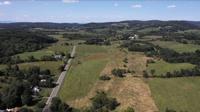COPAKE — Opposing groups came together Thursday to offer suggested ideas about the Shepherd’s Run Solar Farm.
In response to community concerns the working group laid out different ideas they suggested Hecate include in their plan for the project. Their ideas were broken down into four categories — protecting the environment, protecting agriculture, protecting homeowners and benefiting the community.
The proposed 220-acre, 60-megawatt facility is planned for Route 23 and Route 7 in Copake. The project has been a fractious topic among local residents for the past two years, with sometimes heated debates over the project’s scale, the town’s zoning laws and the potential impact the project could have on the environment and property values.
A working group consisting of members of Sensible Solar for Rural New York, Friends of Columbia Solar, Columbia Land Conservancy and Scenic Hudson met to discuss ideas for Hecate Energy, the project’s developer to take into consideration for their plan.
The group presented its ideas to Hecate last week and held a Zoom meeting Thursday attended by more than 140 people to hear suggestions for the project.
Sensible Solar and working group member Meredith Kane said the groups began meeting last fall.
“To talk about really trying to focus on what would it take to make the Shepherd’s Run project one that could actually be a win-win for Copake, and the whole Copake community for our environment, for our farms, our economy, for our residents for our school kids as well as the undeniable benefits that a solar project has for climate change,” Kane said.
“We started envisioning what would it be like to have over 300 acres of new community-accessible green space,” Friends of Columbia Solar and working group member Bradley Pitts said. “We’re envisioning what we’re calling a polyculture park dedicated to the production of energy, culture and food for humans and wildlife alike.”
Community gardens, an extension to the Rail Trial, walking trails are some of the ideas Pitts spoke about which would he said could enhance use of the area around the project. He explained this could help increase tourism to the town.
The working group also discussed protecting agriculture through the use of agrivoltaics, which is the integration of farming and solar power.
“It could be crop farming and or animal grazing beneath and in between solar panels,” Pitts said. “This is a new and upcoming field technique, but given the agricultural importance of the land and even the role rural agriculture plays in the Copake identity, this is a big point for us.”
Agrivoltaics will help allow for the land to be used for farming, Pitts said. It is standard for solar developers to pay farmers to farm land under solar panels. He explained this creates additional job opportunities.
The group also asked Hecate not to clear-cut the existing trees and incorporate scenic screening, integrate the solar panels and utilize native plant species. Columbia Land Conservancy President Troy Weldy said Hecate has agreed to change from using chain-link fencing to animal-friendly fencing that will keep out deer but allow small animals to move through the site.
“We are hopeful that combining wildlife fencing with certain plantings to allow for the movement of wildlife around the fenced areas,” Weldy said.
The working group discussed a number of additional ideas in their presentation which can be seen on the groups website, CraryvilleGateway.org
Hecate issued a notice of intent to file an application with a date on or about Friday, said Audrey Friedrichsen, the land use and environmental advocacy attorney for Scenic Hudson said. A number of local residents on the meeting call said they had received information about the notice of application in the mail from Hecate.
“We still don’t have the application completed, so we can’t file,” project developer Alex Campbell said Friday morning. “It’s all notices. Today is the 18th, it’s not going to happen today, I can guarantee that.”
Campbell said his key takeaway from Thursday’s feedback was to get as much of the recommendations into the application prior to submitting.
Hecate has an outline of what they have done and what they have committed to doing on the website Campbell said.
Some of the changes Hecate has made to its plan for the projects include, downsizing the project from 480 acres to 220 acres, removing the battery storage component of the project, included co-utilization plans within panels to incorporate livestock grazing, committed to not source panels from suppliers who utilize forced labor or that contain PFAS, increased landscaping buffers after feedback from the town and working group, collaborated with the Harlem Valley Rail Trail to help support the extension of the trail, the landscaping plan utilizes native and naturalized species and includes approximately 800 trees and 800 shrubs which Hecate will source from local farmers and more according to their website, http://www.shepherdsrunsolar.com/working-group
Johnson Newspapers 7.1











